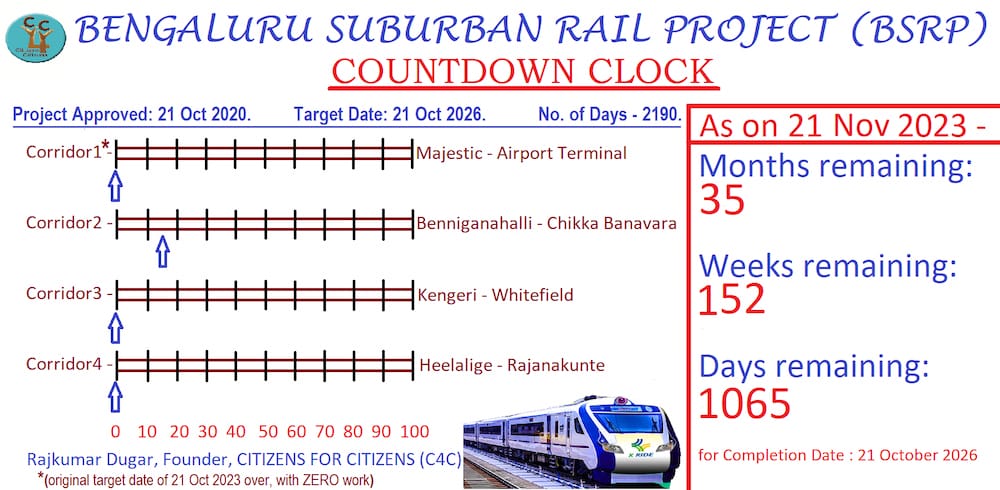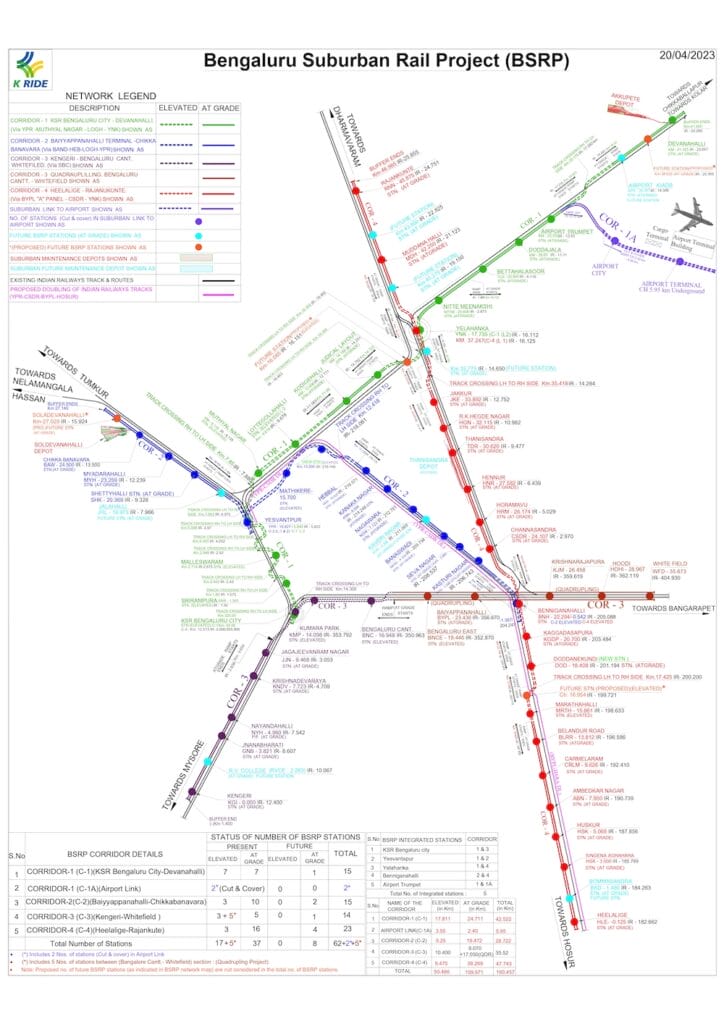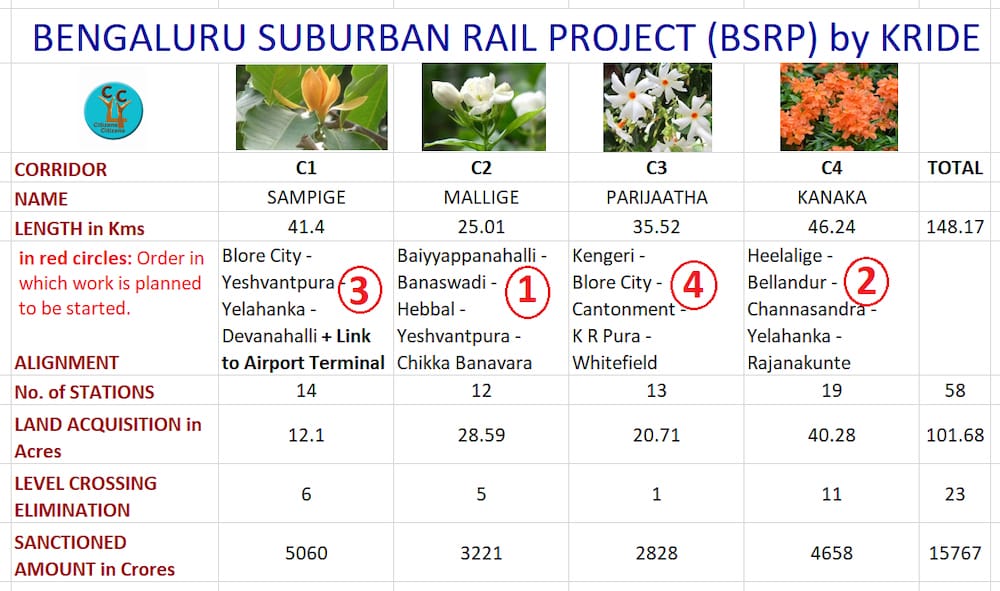Bengaluru Suburban Rail Project (BSRP) is the first project taken up under Government of India’s (GoI) new Suburban Rail Policy. From that angle, it is of national importance. How it pans out will have a bearing on future projects under this Policy. Therefore, Bengaluru cannot afford to fail itself and the country.
Background of the project
After decades of discussions, on 21 October, 2020, BSRP was sanctioned to be built at a cost of Rs. 15,767 crores with four corridors crisscrossing Bengaluru over a total length of 148 kilometres.
The Sanction Letter not only specified completion period as six years, but also stipulated that the Airport Corridor be commissioned in three years.
Rail Infrastructure Development Company (Karnataka) Limited, or KRIDE, a joint venture company with 51% stake by Government of Karnataka (GoK) and 49% by Ministry of Railways, was tasked to execute this Project.
KRIDE’s Board of Directors is headed by Chief Secretary, GoK. Although most work of KRIDE is with Railways/GoI, more control is with GoK. Funding will be 20% each by GoK and GoI; and the remaining 60% by external borrowings.
Before sanction, a lot of expectation led to some preparatory planning by KRIDE, especially for the Airport Corridor. However, BMRCL wrote to GoK asking for KRIDE to build other corridors first. GoK asked the Directorate of Urban Land Transport (DULT) for its opinion. DULT’s response was unambiguous: KRIDE’s BSRP Corridor to Airport should be the “preferred” choice.
Citizens for Citizens (C4C) came out with a list of 21 reasons why the BSRP Airport Corridor is important. However, BMRCL’s view prevailed. KRIDE was asked to de-prioritise its Airport Corridor, while BMRCL went full steam ahead with its own Airport Corridor.
On 20 June, 2022, 20 months after sanction of this 72-month project, the Foundation Stone was formally laid by Hon. Prime Minister Narendra Modi, who publicly assured that BSRP would be commissioned “within 40 months”, i.e. by October 2025 – a full year BEFORE what the Sanction Letter stipulated. This should have pushed everyone into action mode, but surprisingly did not.
Meanwhile, several concerned citizens, who regularly updated themselves about the status of BSRP, kept pushing for work to start. Eventually, work started in December 2022 when Larsen & Toubro began building Corridor2 – Benniganahalli (near Baiyyappanahalli) to Chikka Banavara via Yeshwantpur.
Read more: Will Bengaluru’s suburban rail project speed up?
Current status
After 37 months, the current status of BSRP is disappointing. The only Tender awarded is for C2, where work is happening at an excruciatingly slow pace: Less than 16% work done in about 12 months. No work has started in the other three Corridors. Taking all four Corridors into account, less than 4% work is done after 53% of the Sanction Period being over. Important Tenders for Rolling Stock (Trains), Signalling & Telecommunication are yet to be awarded. All this does not augur well for timely completion of the Project.
Some hope
After suggestions from C4C, concerned citizens were invited by KRIDE for a meeting to discuss various aspects of BSRP, on July 15th this year. It was indeed a positive icebreaker. A wave of reviews by various concerned public representatives and officials also followed – including by Tejasvi Surya, M B Patil, and Member (Infrastructure) of Railway Board. On August 1st, C4C came out with a YouTube video to create more awareness about BSRP among citizens. This already has about 9,000 views.
Another request from C4C was complied with when M B Patil formally released the first newsletter, Samparka from KRIDE, on November 9th. The signing of a tripartite MOU among GoI, GoK and KRIDE on November 15th, regarding the role of each Party in this Project, was another positive development.
Challenges and way forward
The need of the hour is to have a capable, full-time, hands-on Managing Director (MD), preferably a technocrat with Indian Railway Service of Engineers (IRSE) background, to take the Project forward quickly while ensuring KRIDE works strongly and unitedly as a well-oiled machine. Presently, KRIDE has an “in-charge” MD, who is overloaded with responsibilities in other GoK Departments. All vacancies need to be filled, particularly critical ones like General Manager-Finance and General Manager-HR. The requirements of lending agencies have to be addressed quickly so that loans are sanctioned.
Tenders for C1, C4, C3, Rolling Stock, Stations and Signalling & Telecommunication must be awarded on high priority. Constant high-level reviews, monitoring and facilitation are another need. PMO, Gati Shakti, Railway Board, IDD of GoK, etc., must carry out their part. Intermediate targets of work completed must be adhered to – minimum 4 % to 5% every month henceforth on each corridor.
The eight ends of the four Corridors need to be extended to nearby towns, to further decongest the city as well as to ensure the development of nearby towns like Chikkaballapura, Doddaballapura, Nelamangala/Tumakuru, Kunigal, Bidadi/Ramanagara, Anekal/Hosur, Bangarpet/KGF, etc. Planning, approvals, etc. for extensions must be in place as soon as any corridor is commissioned.
A new challenge has cropped up with South Western Railways writing to KRIDE and turning down its request to allow a pre-feasibility study to extend the ends of the four Corridors. It is extremely important for KRIDE to be allowed to extend these since, without extensions, there will be no seamless and efficient commute possible. C4C has written to Chairperson Railway Board requesting to allow the pre-feasibility study to extend the corridors.
C4C has suggested a committee, which includes concerned MPs, to oversee the Project. We wish all MLAs of the city and the surrounding areas to also take interest in this Project since it will impact commute in all areas. It will be great if a formal committee of concerned citizens is also set up for regular updates and user consultations. At any rate, regular interactions will help.
Read more: Suburban rail for Bengaluru: trapped in announcements
Massive benefits from BSRP to quality of life in and around Bengaluru
BSRP is designed to take 10 lakh people off the roads. Its stations will be better integrated with other nearby public transport modes (bus, metro and railway stations). BSRP stations will be modern, dedicated, multi-purpose ones with AC trains every 5 to 12 minutes in both directions.
BSRP trains will have comfortable seating along with some luggage space. Cost of construction will be significantly lower compared to Metro, resulting in huge savings. Hopefully, the tariff will be less than Metro, even though it is unfortunately stipulated to be “comparable” to Metro. During construction, disruption to road traffic will be negligible since it is mainly built away from the roads.
BSRP will have dedicated double tracks along all four Corridors. With six or nine coaches, the trains will have higher carrying capacity and higher average speed, since the average inter-station gap is 2.5 kilometres. Extensions to nearby towns will bring huge additional benefits. As a bonus, KRIDE is eliminating Level Crossings at 26 locations in the city, which presently are major bottlenecks during train movements.
Action taken to make authorities accountable
To build pressure and remind concerned authorities that every single day matters henceforth, C4C has started a countdown clock , which we shall initially put out once a month and from January 2024, bring it out weekly.



Suburbsn rail is not covered near vidyaranyapura Or Yelahaka, pl include as there is no metro Connectivity to vidyaranyapura. The metrotrain can be extended to BELcircle or mathikere organgammacircle so that vidyaranyapura will be connected